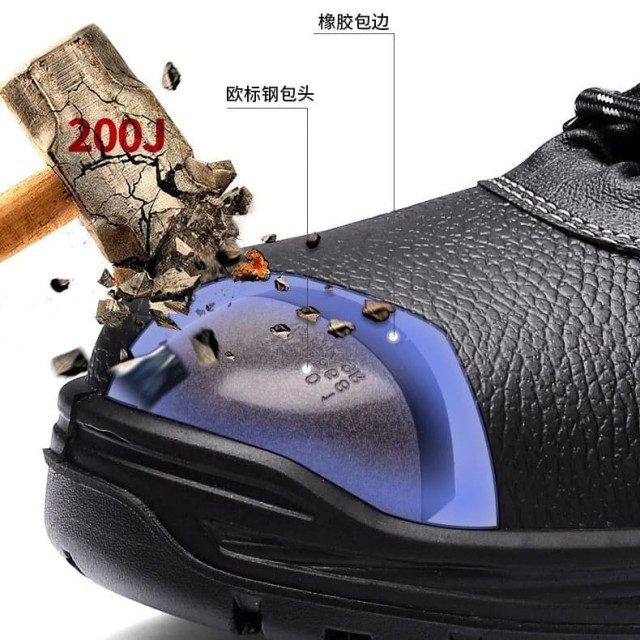Selecting the right safety toe material isn’t just about compliance—it’s about matching protection to your daily risks. Whether you’re navigating electrical grids, metal detectors, or extreme temperatures, the wrong choice can compromise safety and comfort. Here’s how to align OSHA standards, workplace conditions, and material properties for optimal protection.
Safety Toe Material Basics
Steel vs. Composite: Core Differences in Protection and Limitations
Steel toes are the traditional choice, offering high impact resistance (meeting ASTM F2413 standards for compression and impact) at a lower cost. However, they conduct temperature extremes and electricity, making them unsuitable for electrical work or freezing environments.
Composite toes, made from materials like fiberglass or carbon fiber, provide comparable protection without conductivity risks. They’re lighter and metal-detector-friendly but may degrade faster in high-heat industrial settings.
Key takeaway:
- Steel excels in durability and cost but fails in electrical/thermal insulation.
- Composite avoids conductivity issues but sacrifices longevity in harsh conditions.
Aluminum/Alloy Toes: A Middle Ground?
Aluminum toes split the difference: lighter than steel and less conductive, yet more durable than composites. However, they’re less common due to higher costs and limited ASTM certifications for extreme hazards.
Work Environment Considerations
Electrical Hazard Compliance and Material Conductivity
OSHA mandates non-conductive footwear (EH-rated) for electrical work. Composite toes are the only option here—steel or aluminum can create electrocution risks. Research confirms composite materials insulate against electrical currents, aligning with ASTM F2413’s EH standards.
Metal Detector-Friendly Workplaces and Non-Metallic Options
Airports, prisons, and secure facilities often prohibit metal. Composite toes avoid the hassle of repeated screenings while still meeting safety standards.
For these environments:
- Prioritize composite or non-metallic alloy toes.
- Verify ASTM F2413-18 certification for impact/compression.
Safety Standards and Certifications
ASTM F2413 Requirements for Impact/Compression Resistance
All safety toes must pass ASTM F2413 testing, which includes:
- Impact resistance: Withstands a 75-lb object dropped from 1 foot (designated as "I75").
- Compression resistance: Supports 2,500 lbs of static pressure ("C75").
Pro tip: Check for "EH" (Electrical Hazard) or "SD" (Static Dissipative) markings if your work involves sparks or flammable materials.
Industry-Specific Guidelines
- Construction/Oil & Gas: Steel toes handle heavy debris but avoid them near live wires.
- Utilities/Electrical Work: Composite toes are mandatory for EH compliance.
- Warehousing: Lightweight composites reduce fatigue during long shifts.
Cost vs. Durability Trade-Offs
Long-Term Wear of Composite Materials
While composites cost ~20–30% more upfront, they outperform steel in:
- Thermal insulation: No cold transfer in freezers or heat absorption in foundries.
- Weight reduction: Less fatigue over 10-hour shifts.
However, prolonged exposure to temperatures above 300°F can weaken composites.
Replacement Costs for Damaged Steel vs. Composite Toes
Steel toes dent but rarely fail catastrophically; composites may crack under extreme force and require replacement sooner.
Budgeting advice:
- High-hazard industries (e.g., steel mills): Invest in steel.
- Moderate-risk settings (e.g., warehouses): Composites offer better ROI.
Final Recommendation
Match your toe material to your workplace’s primary hazard:
- Impact/crush risks + budget constraints → Steel
- Electrical/thermal hazards → Composite
- Lightweight + security checks → Non-metallic alloys
Upgrade your safety footwear today: 3515’s range of ASTM-certified boots combines advanced materials with industry-specific designs. Whether you’re a distributor equipping a construction crew or a brand owner sourcing EH-rated boots, our solutions balance protection, compliance, and comfort. Contact 3515 for bulk orders tailored to your workforce’s needs.
Did this guide clarify your safety toe options? Share your workplace scenario in the comments for personalized recommendations.
Products You Might Be Looking For:
Explore customizable safety footwear for workplace hazards
Related Products
- Wholesale Durable Breathable Safety Boots Custom OEM Manufacturer
- Customizable Anti-Smash Safety Boots for Wholesale & Private Label Manufacturing
- Athletic Safety Shoes with Dial Closure & Steel Toe for Wholesale & Custom Manufacturing
- Wholesale Anti-Smash & Puncture-Proof Safety Shoes Custom Manufacturing for Brands
- Wholesale Mesh Steel Toe Safety Shoes with Dial Closure Factory Production
Related Articles
- Steel Toe vs. Composite Toe Boots: How to Choose the Right Safety Footwear for Your Job
- How Modern Steel Toe Boots Combine Safety with All-Day Comfort
- Steel Toe Work Boots: Balancing Safety and Comfort for Demanding Jobs
- Matching Men’s Work Shoe Safety Technologies to Workplace Hazards
- How to Prevent Foot Injuries from Steel Toe Boots Without Sacrificing Safety



















